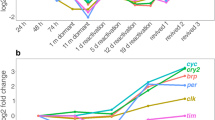Abstract
DURING recent years, dipterous larvae possessing giant polytene chromosomes have provided important new insight into developmental physiology at the sub-cellular level. This is in large measure attributable to the phenomenon of chromosomal ‘puffing’, which has afforded the opportunity for visualizing the changing pattern of genetic activity within individual tissues during the course of development1. Clever2 has reported significant alterations in the puffing pattern of salivary gland chromosomes from a laboratory population of Chironomus tentans which experienced a state of spontaneously arrested development under conditions seemingly favourable for continued growth and metamorphosis. Although not previously described for this organism, the developmental arrest resembles the diapause which typifies the life-histories of many insect species. Diapause is commonly induced or terminated by extrinsic environmental factors, particularly temperature and photoperiod, which exert their effect by influencing the activity of the endocrine system which regulates insect growth and metamorphosis3. In view of the paucity of information on these matters in the case of C. tentans, coupled with the general utility of dispausing insects and the special cytological attractions of this species for investigations of biochemical mechanisms underlying growth and differentiation, we have examined the natural occurrence of a larval diapause and its photoperiodic control under laboratory conditions.
This is a preview of subscription content, access via your institution
Access options
Subscribe to this journal
Receive 51 print issues and online access
$199.00 per year
only $3.90 per issue
Buy this article
- Purchase on Springer Link
- Instant access to full article PDF
Prices may be subject to local taxes which are calculated during checkout
Similar content being viewed by others
References
Beermann, W., Chromosoma, 5, 139 (1952); Z. Naturforsch., 7B, 237 (1952); Chromosoma, 12, 1 (1961). Mechelke, F., ibid., 5, 511 (1953). Breuer, M. E., and Pavan, C., ibid., 7, 371 (1955). Becker, H. J., ibid., 10, 654 (1959). Kroeger, H., ibid., 11, 129 (1960). Clever, U., ibid., 12, 607 (1961); 13, 385 (1962).
Clever, U., J. Insect Physiol., 8, 357 (1962).
Lees, A. D., The Physiology of Diapause in Arthropods (Camb. Univ. Press Lond., 1955).
Paris, jun., O. H., and Jenner, C. E., Photoperiodism and Related Phenomena in Plants and Animals, 601 (Amer. Assoc. Adv. Sci., Washington, Publ. No. 55).
McLeod, D. G. R., and Beck, S. D., Biol. Bull., 124, 84 (1963).
Shakhbazov, V. G., Dokl. Akad. Nauk S.S.S.R. (Biol. Sci.), 140, 249 (1961) Williams, C. M., Science, 140, 386 (1963). Williams, C. M., and Adkisson, P. L., Biol. Bull., 127, 511 (1964).
Pause, J., Zool. Jb. (Abt. Allg. Zool. Physiol.), 36, 339 (1918). Sadler, W. O., Cornell Univ. Agric. Exp. Sta., Ithaca, New York, Mem. No. 173 (1935).
De Wilde, J., Ann. Rev. Entomol., 7, 1 (1962).
Lees, A. D., in Cryptobiotic Stages in Biological Systems, edit. by Grossowicz, N., Hestrin, S., and Keynan, A., 130 (Elsevier Publ. Co., Amsterdam, 1961).
Author information
Authors and Affiliations
Rights and permissions
About this article
Cite this article
ENGLEMANN, W., SHAPPIRIO, D. Photoperiodic Control of the Maintenance and Termination of Larval Diapause in Chironomus tentans. Nature 207, 548–549 (1965). https://doi.org/10.1038/207548a0
Published:
Issue Date:
DOI: https://doi.org/10.1038/207548a0
This article is cited by
-
Combined effects of photoperiod and temperature on the diapause of an intertidal chironomid
Oecologia (1985)
-
Two circadian eclosion times in Chironomus thummi (Diptera), alternately selected with different temperatures
Oecologia (1979)
-
Experimental contributions to the ecology of Chironomus (Diptera)
Oecologia (1979)
-
Physiologische anpassungen eines marinen insekts. I. Die zeitliche steuerung der entwicklung
Marine Biology (1976)
-
Experimentelle Beitr�ge zur �kologie von Chironomus (Diptera)
Oecologia (1974)
Comments
By submitting a comment you agree to abide by our Terms and Community Guidelines. If you find something abusive or that does not comply with our terms or guidelines please flag it as inappropriate.



